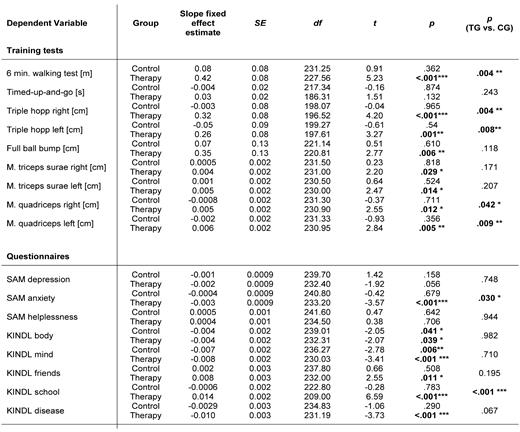P Glogowski and L Thérond contributed equally to this work. Background
Pediatric patients receive physiotherapy support during hematopoietic stem cell transplantation (HSCT) to prevent the deterioration of condition and musculature and to promote rehabilitation. Despite the good arguments in favor of physiotherapy, children often do not enjoy the exercises, or even refuse to participate. In our prospective study we show that our unique training program on the trampoline is convincing and superior to the standard physical therapy during HSCT. Patients and Methods
In this monocentric, randomized, prospective study of the University Children's Hospital Tübingen, 52 HSCT patients between 5 and 22 years of age were followed during the in-patient stay in the context of HSCT, as well as in the post-transplant period until day +200 after HSCT. The therapy group (TG; n=26; TG) received a specially created exercise program five days a week with elements of strength and endurance training using a trampoline and an exercise ball. The TG was compared with a control group (CG; n=26) that received standard physical therapy. After in-patient discharge, TG patients were given an exercise plan and an exercise diary to complete independently at home.
On six predefined approximate observation days (baseline: day of in-patient admission before HSCT, between day +3 to +8 after leukocyte/granulocyte “take”, after HSCT, day +60, day +100, day +150, and day +200 after HSCT), patients in both groups were assessed for muscle strength (full-ball bump, triple hop), stamina and endurance (timed-up-and-go, 6-minute walking), muscle development (muscle circumferences of M. triceps surae and M. quadriceps), emotional state and quality of life (questionnaires: SAM, KINDL-Onco-module). Data from the training tests, as well as from the questionnaires was used to fit linear mixed models. The equation used to fit the models can be described by DV ijk = β 0j + β 1j * day k + ϑ 0i + ϑ 1i + ε ijk. In this model equation DV ijk denotes the dependent variable of patient i = 1, ..., 52, in group j = 1 (CG) or 2 (TG), at day k = -53, ..., 367 after HSCT. β 0j and β 1j denote the fixed effects where β 0j is the intercept estimate (i.e. the dependent variable at day 0 after HSCT) and β 1j is the slope estimate (i.e. how much the dependent variable decreases or increases each day) for the respective group j. ϑ 0i and ϑ 1i describe the individual specific random intercept and slopes, while ε ijk is the error term. Results
A total of 52 patients with a median age of 9.8 years (range 5.2 to 20.3 years), 29 of whom were females (55.8%), were included in this study. Of the patients, 45 (86.5%) and 7 (13.5%) underwent allogeneic or autologous HSCT, respectively. The underlying diseases were malignant in 63.5% of the cases (e.g., acute lymphoblastic leukemia, acute myeloid leukemia, neuroblastoma) and non-malignant in 36.5% of the cases (e.g., beta-thalassemia, sickle cell disease). The granulocyte and leukocyte take were each reached at a median of day +17 (range day +8 to day +30). The estimated fixed effects of the slopes of the analyzed data for the training tests and questionnaires can be found in the table.
In the TG, there was a significant increase in the results of the walking test, the triple hop, the full ball bump, and triceps and quadriceps circumferences. No significant improvement over time was found in the CG. Looking at the difference between groups, the improvement in the TG was significantly greater for the walking test, the triple hop, and the quadriceps circumferences.
For the questionnaire data, it was shown that both the CG and the TG had a significant decrease in debilitating physical, as well as debilitating psychological symptoms over time (KINDL body and KINDL mind). There was no significant difference between groups in these scales. For self-reported anxiety (SAM) and illness-related worries (KINDL disease) there was a significant decrease, while the scales KINDL friends and KINDL school increased significantly in the TG but not in the CG. For anxiety and the KINDL school scale this improvement was significantly greater in the TG than in the CG. Conclusions
Our unique and new trampoline-based exercise program was able to counter standard physical therapy with significant improvements in muscle strength, endurance, as well as a reduction in anxiety and worry and an improved quality of life for the patients. And most importantly, our patients had an incredible amount of fun doing it.
Disclosures
Seitz:Miltenyi Biotec: Research Funding, Speakers Bureau.


This feature is available to Subscribers Only
Sign In or Create an Account Close Modal